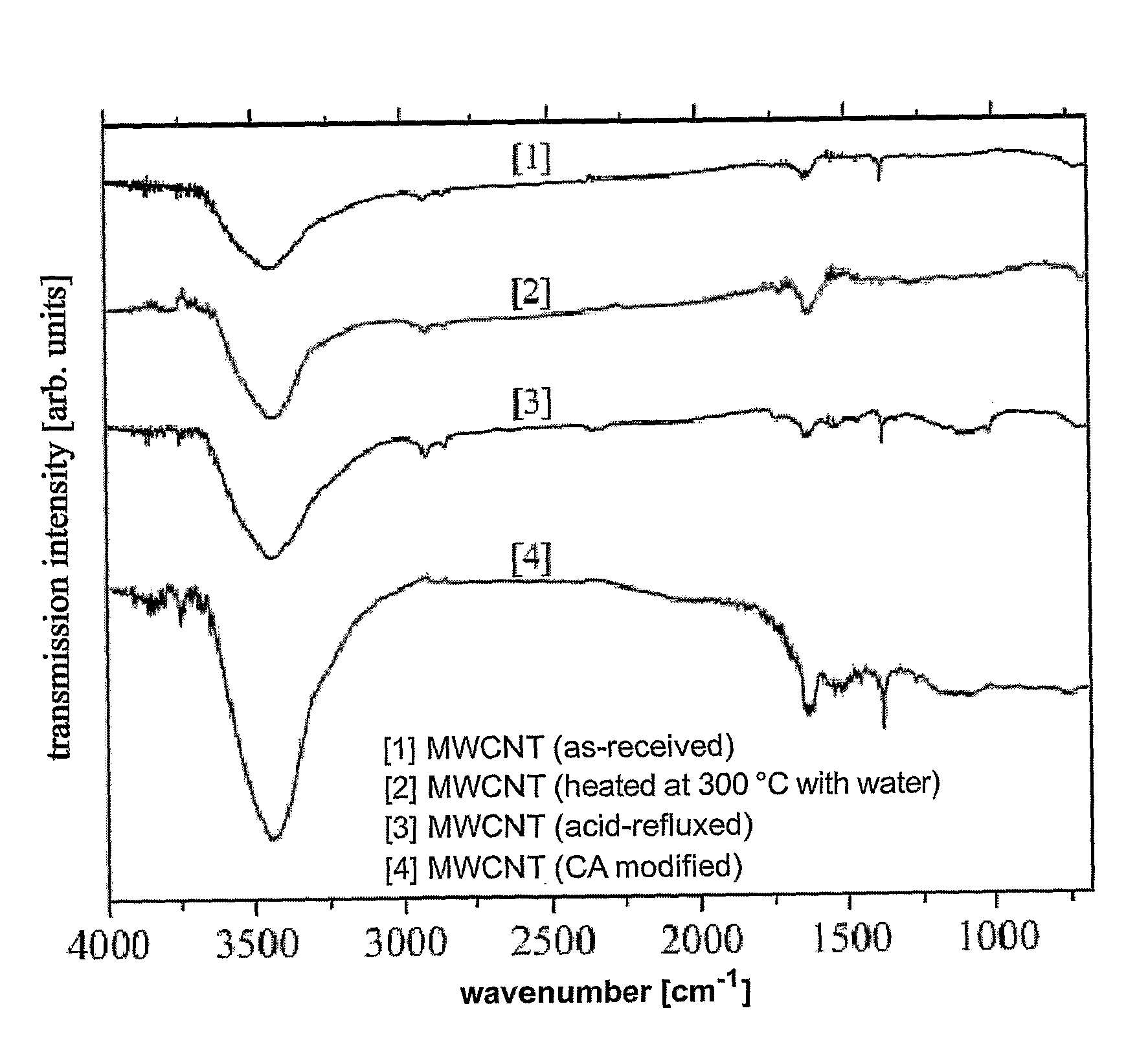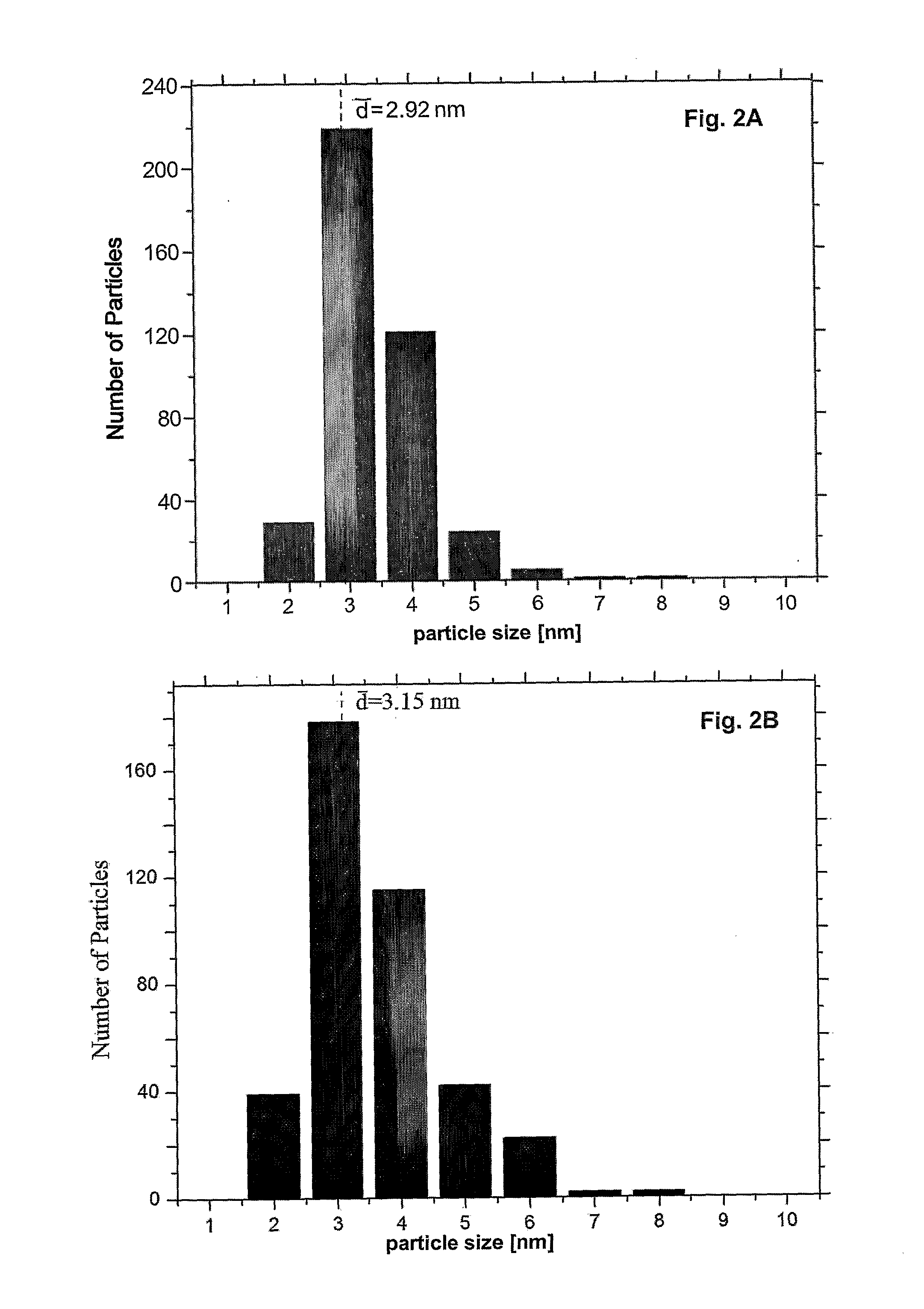Method of functionalizing a carbon material
a carbon material and functionalization technology, applied in the field of can solve the problems of negatively charging carbon nanotubes, functional groups rendering carbon materials hydrophobic, and chemical functionalization of carbon materials traditionally posed a challeng
- Summary
- Abstract
- Description
- Claims
- Application Information
AI Technical Summary
Problems solved by technology
Method used
Image
Examples
example 1
Citric Acid Treatment of Multi-Walled Carbon Nanotubes
[0065]The present example illustrates an embodiment of functionalizing carbon nanotubes as a model carbon material. Pt nanoparticles are then formed on the carbon nanotubes, thereby obtaining a catalyst for a fuel cell.
[0066]The average length of carbon nanotubes used in the current example was ˜2 μm. The carbon nanotubes were suspended in deionized water (DI water). All dielectrophoresis experiments were done under standard room temperature conditions.
[0067]In a typical experiment, 100 mg of multi-walled carbon nanotubes (purchased from Shenzhen Nanotech Co. Ltd. with diameters between 20 to 40 nm), 100 mg of citric acid monohydrate (Fluka 99.5%) and 10 ml of distilled water were mixed with the help of ultrasonic vibration (Elma, 100 W and 35 kHz) for 15 min, and then let dried to form a paste. After heated at 300° C. for 30 min, the citric acid treated multi-walled carbon nanotubes were ready for Pt deposition. The same procedu...
example 2
Deposition of Platinum Nanoparticles on Multi-Walled Carbon Nanotubes
[0068]40 mg of the above functionalized multi-walled carbon nanotubes were dispersed in 50 ml of ethylene glycol (Sigma Aldrich 99+%) by ultrasonic vibration and mixed with 1.0 mL of 0.04M H2PtCl6.6H2O (Fluka) aqueous solution in a Teflon vessel. 0.5 mL of 0.8 M NaOH was added drop wise into the mixture and stirred vigorously. The mole ratio of NaOH / Pt was >8 to induce small and uniform Pt particles formation (Yu, W., et al., Langmuir (1999) 15, 1, 6-9). The Teflon vessel with the mixture was placed in the Milestone MicroSYNTH programmable microwave system (1000 W, 2.45 GHz), heated to 160° C. within 2 min, and maintained at the same temperature for 2 min for the reduction of the platinum precursor. The resulting suspension of Pt-deposited carbon nanotubes were centrifuged, washed with acetone to remove the organic solvent, and dried at 80° C. overnight in a vacuum oven.
[0069]To compare the carbon nanotubes modifie...
example 3
Catalyst Characterization
[0070]The Pt particle size distribution was examined using TEM (JEOL JEM2010F) operating at 200 kV. A total of 400 Pt nanoparticles were counted in each sample to ensure statistically representative of the particle distribution.
[0071]The platinum loading of the catalyst was determined using a thermogravimetry analyzer (TGA) (Setaram TGA equipment). Several milligrams of the Pt / carbon samples were heated to 800° C. in the flow of purified oxygen.
[0072]The infrared transmission spectra were measured with a Perkin-Elmer 2000 Fourier-Transform Infrared Spectrometer (FTIR) in the range of 400 to 4000 cm−1.
[0073]X-ray diffraction (XRD) measurements, were carried out using a Bruker D8 Advance X-Ray Diffractometer, scanned from 20=10° to 90°. The average crystallite size of Pt particles was estimated from the diffraction peak of Pt(111) using the Debye-Scherrer equation (Antolini, E., & Cardellini, F., J. Alloys Comp. (2001) 315, 118):
d=0.9λkα1 / B cos θmax (1)
in whi...
PUM
| Property | Measurement | Unit |
|---|---|---|
| Time | aaaaa | aaaaa |
| Time | aaaaa | aaaaa |
| Time | aaaaa | aaaaa |
Abstract
Description
Claims
Application Information
 Login to View More
Login to View More - R&D
- Intellectual Property
- Life Sciences
- Materials
- Tech Scout
- Unparalleled Data Quality
- Higher Quality Content
- 60% Fewer Hallucinations
Browse by: Latest US Patents, China's latest patents, Technical Efficacy Thesaurus, Application Domain, Technology Topic, Popular Technical Reports.
© 2025 PatSnap. All rights reserved.Legal|Privacy policy|Modern Slavery Act Transparency Statement|Sitemap|About US| Contact US: help@patsnap.com



